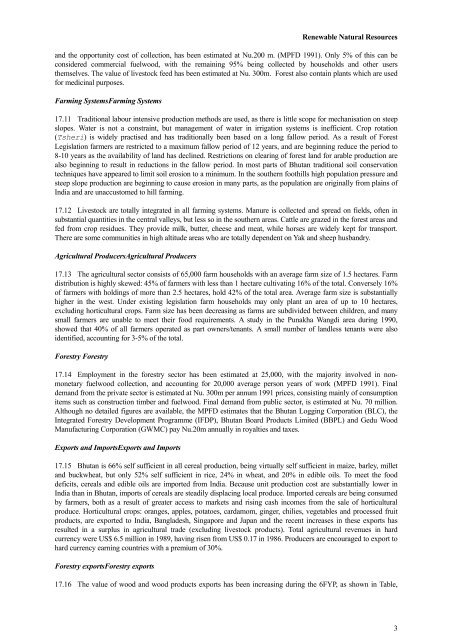COUNTRY BACKGROUND - Gross National Happiness Commission
COUNTRY BACKGROUND - Gross National Happiness Commission
COUNTRY BACKGROUND - Gross National Happiness Commission
Create successful ePaper yourself
Turn your PDF publications into a flip-book with our unique Google optimized e-Paper software.
Renewable Natural Resources<br />
and the opportunity cost of collection, has been estimated at Nu.200 m. (MPFD 1991). Only 5% of this can be<br />
considered commercial fuelwood, with the remaining 95% being collected by households and other users<br />
themselves. The value of livestock feed has been estimated at Nu. 300m. Forest also contain plants which are used<br />
for medicinal purposes.<br />
Farming SystemsFarming Systems<br />
17.11 Traditional labour intensive production methods are used, as there is little scope for mechanisation on steep<br />
slopes. Water is not a constraint, but management of water in irrigation systems is inefficient. Crop rotation<br />
(Tsheri) is widely practised and has traditionally been based on a long fallow period. As a result of Forest<br />
Legislation farmers are restricted to a maximum fallow period of 12 years, and are beginning reduce the period to<br />
8-10 years as the availability of land has declined. Restrictions on clearing of forest land for arable production are<br />
also beginning to result in reductions in the fallow period. In most parts of Bhutan traditional soil conservation<br />
techniques have appeared to limit soil erosion to a minimum. In the southern foothills high population pressure and<br />
steep slope production are beginning to cause erosion in many parts, as the population are originally from plains of<br />
India and are unaccustomed to hill farming.<br />
17.12 Livestock are totally integrated in all farming systems. Manure is collected and spread on fields, often in<br />
substantial quantities in the central valleys, but less so in the southern areas. Cattle are grazed in the forest areas and<br />
fed from crop residues. They provide milk, butter, cheese and meat, while horses are widely kept for transport.<br />
There are some communities in high altitude areas who are totally dependent on Yak and sheep husbandry.<br />
Agricultural ProducersAgricultural Producers<br />
17.13 The agricultural sector consists of 65,000 farm households with an average farm size of 1.5 hectares. Farm<br />
distribution is highly skewed: 45% of farmers with less than 1 hectare cultivating 16% of the total. Conversely 16%<br />
of farmers with holdings of more than 2.5 hectares, hold 42% of the total area. Average farm size is substantially<br />
higher in the west. Under existing legislation farm households may only plant an area of up to 10 hectares,<br />
excluding horticultural crops. Farm size has been decreasing as farms are subdivided between children, and many<br />
small farmers are unable to meet their food requirements. A study in the Punakha Wangdi area during 1990,<br />
showed that 40% of all farmers operated as part owners/tenants. A small number of landless tenants were also<br />
identified, accounting for 3-5% of the total.<br />
Forestry Forestry<br />
17.14 Employment in the forestry sector has been estimated at 25,000, with the majority involved in nonmonetary<br />
fuelwood collection, and accounting for 20,000 average person years of work (MPFD 1991). Final<br />
demand from the private sector is estimated at Nu. 300m per annum 1991 prices, consisting mainly of consumption<br />
items such as construction timber and fuelwood. Final demand from public sector, is estimated at Nu. 70 million.<br />
Although no detailed figures are available, the MPFD estimates that the Bhutan Logging Corporation (BLC), the<br />
Integrated Forestry Development Programme (IFDP), Bhutan Board Products Limited (BBPL) and Gedu Wood<br />
Manufacturing Corporation (GWMC) pay Nu.20m annually in royalties and taxes.<br />
Exports and ImportsExports and Imports<br />
17.15 Bhutan is 66% self sufficient in all cereal production, being virtually self sufficient in maize, barley, millet<br />
and buckwheat, but only 52% self sufficient in rice, 24% in wheat, and 20% in edible oils. To meet the food<br />
deficits, cereals and edible oils are imported from India. Because unit production cost are substantially lower in<br />
India than in Bhutan, imports of cereals are steadily displacing local produce. Imported cereals are being consumed<br />
by farmers, both as a result of greater access to markets and rising cash incomes from the sale of horticultural<br />
produce. Horticultural crops: oranges, apples, potatoes, cardamom, ginger, chilies, vegetables and processed fruit<br />
products, are exported to India, Bangladesh, Singapore and Japan and the recent increases in these exports has<br />
resulted in a surplus in agricultural trade (excluding livestock products). Total agricultural revenues in hard<br />
currency were US$ 6.5 million in 1989, having risen from US$ 0.17 in 1986. Producers are encouraged to export to<br />
hard currency earning countries with a premium of 30%.<br />
Forestry exportsForestry exports<br />
17.16 The value of wood and wood products exports has been increasing during the 6FYP, as shown in Table,<br />
3

















